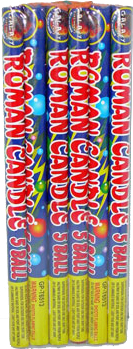 Ingredients
Ingredients- Blue touch paper
- Delay composition
- Red star
- Gunpowder
- Delay composition
- Green star
- Gunpowder
- Clay or plastic base
Published November 2009
A simple Roman candle which emits a red and a green star has the following layers within its thick-walled cardboard tube.
Starting from the top:
Blue touch paper is paper treated with potassium nitrate [KNO3] solution. When lit, a smouldering chemical reaction begins between the cellulose of the paper and the nitrate and this eventually transfers heat to a layer of very finely milled gunpowder at the top of the firework. This begins to burn and ignites the various layers as it works its way down the tube.
Delay composition has 62% potassium nitrate, 18% sulfur and 20% carbon and burns to produces a small display of sparks before eventually igniting a small charge of gunpowder around the sides and below the first star which is then ejected.
Gunpowder is more correctly called black powder, this was invented by the Chinese around 1000 AD and then developed by the English friar Roger Bacon in 1252 who experimented with mixtures of potassium nitrate, sulfur, and charcoal until he came up with the explosive composition of six parts potassium nitrate to five parts each of sulfur and carbon. In his day the potassium nitrate was scraped from the walls of cesspits and latrines where it is formed by the action of bacteria on dung and urine. Such was the demand for potassium nitrate for gunpowder that it was imported from the Far East until ways of making it from animal dung were developed in Europe. Today it is made from nitric acid, as is the strontium nitrate of the next component…
Red star is composed of potassium chlorate [KClO3], strontium nitrate [Sr(NO3)2], strontium carbonate [SrCO3], and aluminium powder held together by a natural gum. The potassium chlorate provides the oxygen which allows the aluminium to burn with an intense hot flame in which are particles of strontium oxide and strontium monochloride (SrCl+) and it is these which emit the characteristic red light. The first strontium mineral, strontium carbonate, was discovered in a mine at the village of Strontian on the west coast of Scotland in 1787 and was shown to be a new element by Thomas Charles Hope of Edinburgh in 1808. There is no substitute for strontium when it comes to providing a bright red flame.
Green star consists of barium chlorate [Ba(ClO3)2], potassium chlorate, and charcoal, held together by a mixture of tree resin and dextrin (which is a carbohydrate produced from starch). When the star burns the barium chlorate produces the positively charged species BaCl+ and it is this which emits the green colour. Rather than using barium chlorate which tend to be rather unstable, some fireworks use a combination of barium nitrate and PVC (polyvinyl chloride) which react to form the BaCl+.